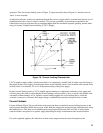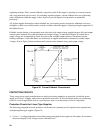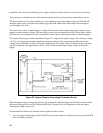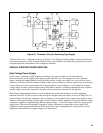
42
Figure 22A. Crowbar Response
Figure 23 shows typical protection circuits that are used in Agilent switching regulated power supplies. Most of
these protection circuits perform functions that are similar to those of the linear supply of Figure 21. However,
their circuit placement, or the manner in which they affect the operation of the supply, is often different.
Several protection circuits (such as the ac undervoltage detector) are required only in switching supplies.
The following is a brief description of the protection circuits shown in Figure 23.
A. RFI Filter- Helps prevent RFI spikes from being conducted to the load or back into the ac line. Agilent
switching supplies also contain built-in shields for additional control of conducted and radiated
interference.
B. Thermistor - Limits ac inrush current by its negative temperature coefficient of resistance. Has a high
resistance when cold (during turn-on) and low resistance after it heats up.
C. Regulator Overcurrent Limit - This circuit is much faster than the current limit comparator and protects the
regulator switches from overcurrent conditions of a transient nature. It monitors current flow through the
switches and prevents it from exceeding a harmful level.
D. Output Rectifier Diodes - Besides final rectification, these diodes also protect internal components against
reverse currents that could be injected into supply by an active load or series connected supply.
E. AC Undervoltage - Performs a dual function. Protects supply from damage that could result from a
prolonged condition of low ac input voltage and limits output overshoot during turn-on. During
undervoltage or turn-on conditions, the low ac input level reduces the V
BIAS
voltage and activates the
undervoltage detector. When activated, the modulator pulses are inhibited and the regulator switches turned
off.
F. Overvoltage Detector- Monitors output voltage and turns-off regulator switches if output attempts to rise
above a preset value. Similar to crowbar circuit described previously, except that output voltage is removed
by turning off regulator rather than by shorting the output.
G. Temperature Switch - Opens in case of high ambient temperature that could be caused, for example, by a
misapplication or cooling fan failure. Opening switch removes V
BIAS
and activates ac undervoltage detector.
Switch closes again after temperature cools to a safe level.


















